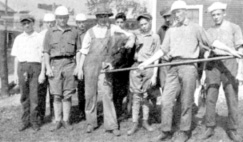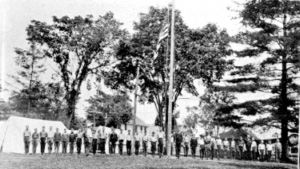World War I: Camp Vail, 1916
Camp Vail was organized in the summer of 1917 because of wartime concern about an inadequate supply of farm labor within the state. To deal with the issue, the Vermont Farm War Council, composed of representatives of agricultural organizations and agencies in the state, appointed Frederick H. Bickford of Bradford as Farm Labor Agent. Bickford conceived the idea of creating a camp to train young Vermont boys in farm work as a means of helping assure an adequate work force at wage rates Vermont farmers could afford to pay. Camp Vail at Lyndon Center, Vermont, was the result. The location was a nearly 2,000-acre area on the farm of Theodore N. Vail, president of the American Telephone and Telegraph Company, near the site of present-day Lyndon State College.
Oral history transcriptions
Click a name below for more information. All transcripts are in PDF format.
Background information
 A poster that was used to advertise the camp proclaimed “The State of Vermont through the Department of Agriculture proposes to Enlist Her Boys for the Farm.” Recruiters for the camp distributed information about the program through posters, newsletters, and personal contacts in high schools. The camp promised to provide “training for service on the farm.” The text of a four-page folder included the following:
A poster that was used to advertise the camp proclaimed “The State of Vermont through the Department of Agriculture proposes to Enlist Her Boys for the Farm.” Recruiters for the camp distributed information about the program through posters, newsletters, and personal contacts in high schools. The camp promised to provide “training for service on the farm.” The text of a four-page folder included the following:
As never before in her history Vermont must use her hills this summer. The hills and fields of Old Vermont Must bring forth their treasures to Back Them Up.
Boys—Younger sons—You’ve got to help.
Father and Mothers of Vermont You must lend her Your Boys.
The farmers of Vermont are doing their utmost.
They Must have help.The Call could not be clearer!
The Need could not be greater.
Your Duty was never plainer.
The Parents of Vermont Must lend her their Younger Sons.
The Boys of Vermont must roll up their sleeves and Get into it.
The Older Sons “Over There” are Pointing the Way.
What Else can we do but Follow it?
The response was positive: enlistment requests exceeded the capacity of the camp.
 Three groups, each of fifty boys, attended the camp for two-week periods. The boys were mostly too young to enlist in the war, ranging in age from 16 to 20 years, and came primarily from the larger towns where the opportunity and knowledge of farming were most lacking. Life at camp was in the military mode. Campers slept in tents and were awakened at 6:30 A.M. by a bugle blast. After being led through a rigorous program of exercise, campers marched to breakfast. A military-style line-up followed breakfast, at which the boys received orders of the day. The campers then marched to their agricultural tasks in squads of ten, each in the charge of an instructor of the school. The period after supper was often taken up with marching drills, but also with singing, sports, and campfires.
Three groups, each of fifty boys, attended the camp for two-week periods. The boys were mostly too young to enlist in the war, ranging in age from 16 to 20 years, and came primarily from the larger towns where the opportunity and knowledge of farming were most lacking. Life at camp was in the military mode. Campers slept in tents and were awakened at 6:30 A.M. by a bugle blast. After being led through a rigorous program of exercise, campers marched to breakfast. A military-style line-up followed breakfast, at which the boys received orders of the day. The campers then marched to their agricultural tasks in squads of ten, each in the charge of an instructor of the school. The period after supper was often taken up with marching drills, but also with singing, sports, and campfires.
Here are two examples of popular war songs that were modified for use at Camp Vail:
[To the tune, “Keep the Home Fires Burning”]
Keep the home soil turning,
Keep the old farm earning.
While our lads are far away,
We’ll work at home.
While the Huns they’re cracking,
They shall have our backing.
Turn the old sod inside out
Till the boys come home.
[To the tune of “Anchors Aweigh”]
Camp Vail’s awake tonight,
Camp Vail’s awake!
It holds a lively bunch,
That’s no mistake.
We’re out to lick the Hun,
William to break.
As our row we hoe,
Kaiser Bill will know
Camp Vail’s awake.
Boys who attended the camp were instructed in haying, dairying, care of horses, woodcutting, truck gardening, and other agricultural skills. In addition, they were taught the importance of faithfulness, honor, and conscientious effort in relations with employers, neighbors, and community. They were also taught the patriotic nature of the entire undertaking. When the training period ended, each boy was placed with a farmer at a wage of $14.00 per week to work through the summer season.
Camp director was Rollo G. Reynolds, director of the Vail Agricultural School. Commandant of the camp was Harvey Wingate. Supervisors were Jerome M. Fitzpatrick, Seth T. Wheat, George A. Burnham, Carroll M. Pike, George Blood, Harley Leland, and Harold Billings. All wore military-style uniforms.
Farm Labor Agent Bickford assessed what was accomplished at Camp Vail:
Personally, I think the greatest help came from the improved morale given the Vermont farmer by those willing to help him. He was encouraged to go ahead and plant his farm feeling that he would be taken care of in some way, and generally he was.
—Gene Sessions
Further reading
“Camp Vail,” in The Vermonter 23, no 4 (1918): 89-97.
John T. Cushing, Arthur F. Stone, Capt. Harold P. Sheldon, eds., Vermont in the World War, 1917-1919. Burlington, Vt.: Free Press Printing, 1928.
Citation for this page
Woodsmoke Productions and Vermont Historical Society, “World War I: Camp Vail, 1916,” The Green Mountain Chronicles radio broadcast and background information, original broadcast 1988-89. https://vermonthistory.org./world-war-i-camp-vail-1916